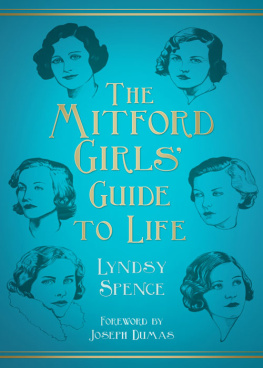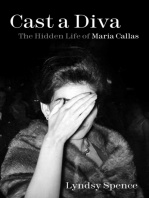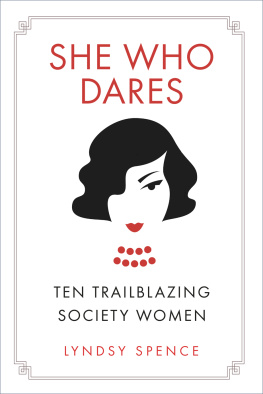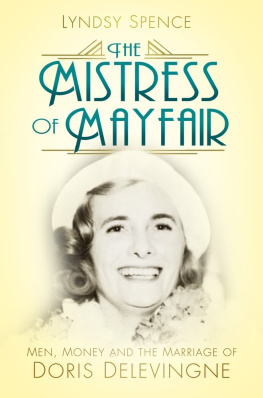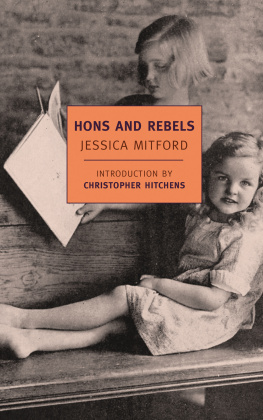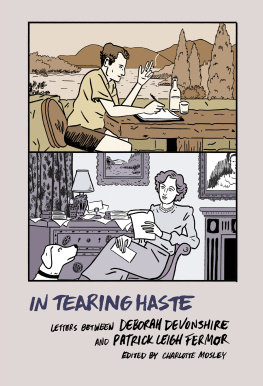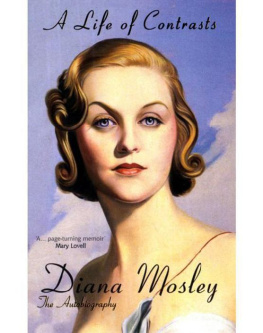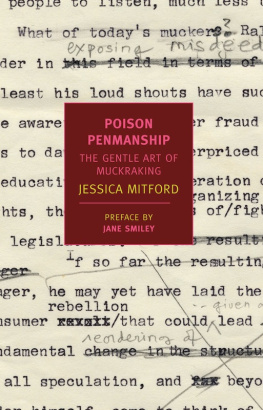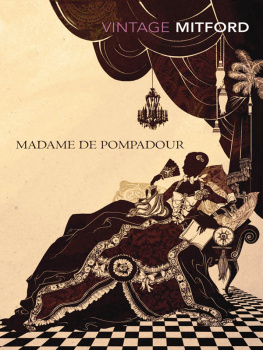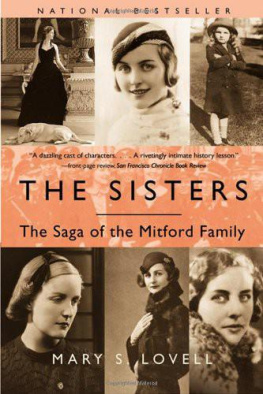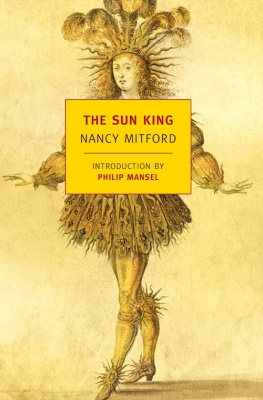This book is dedicated to the following:
My family,
the Counter Hons, Lola & Harriet,
and The Mitford Society.
And most especially Stephen Kennedy, a Honnish friend in every way.
C ONTENTS
B Y J OSEPH D UMAS
When Jessica Mitford died, in 1996, the British press opined that Great Britain in the twentieth century could be viewed through the prism of the Mitford family.
Jessica, whom I came to know in America and London in her final years, was the second youngest of the six Mitford sisters, daughters of the 2nd Baron Redesdale. On two occasions I met Pamela, the second-oldest sister, and on several occasions and through correspondence, Deborah, the Dowager Duchess of Devonshire, the youngest born and now only surviving sister.
By their own accounts, the Mitford girls, a sister act without parallel, were reared to sparkle.
If the Edwardian era whose spirit haunted the Mitford household was measured, say, in slow time, the arrival of the Roaring Twenties ushered in new concepts of motion: motor cars, air travel and all-night parties. By contrast to the silent and inflexible mores of the Edwardians, the Roaring Twenties materialised like a poltergeist unleashed.
Meanwhile, in their leafy, cloistered enclave in the Cotswolds, the sparkling Mitford sisters began to crackle. One could say Nancy the eldest, who went on to write comic novels and highly regarded biographies snuck in the gramophone, wound up its crank, positioned the trumpet, then took to the dance floor in fast time. Soon it became a sister act and none, ever, danced the Wallflower Waltz. Their sparkle, which had begun to crackle, soon detonated.
As the author J.K. Rowling a fan of Jessica Mitfords books has noted, The story of the extraordinary Mitford sisters has never been told as well as they tell it themselves. Keen observation, cracking humour and deft turns of the pen must have been encoded in the Mitford DNA. To them, we owe a debt of joyous gratitude; to their biographers and editors, including, amongst others, Dianas son Jonathan Guinness and his daughter Catherine Guinness, and especially Charlotte Mosley, Dianas daughter-in-law, we, the public, owe a debt of gratitude.
The Mitford Industry is the moniker the sisters themselves, tongue in cheek, appropriated about standing in the crosshairs of the media: scores of newspaper and magazine articles; books; radio programmes; television documentaries; plays; and even a musical. To this catalogue should be welcomed The Mitford Girls Guide to Life by Lyndsy Spence. In todays techno-savvy world, with its iPads, iPhones and Android devices, Spences breathless and delightful narrative could be seen as a Mitford app for todays fast-paced reader.
Joseph Dumas, 2013
First and foremost I should like to thank my friend Stephen Kennedy for his encouragement, ideas, knowledge and original sources. Without Stephens thoughtful guidance the book would not have taken a unique approach in telling the Mitford story.
I am also extremely grateful to the following people for their contributions: Goldie Newport for kindly sharing her invaluable memories of Pamela Mitford; Debbie Catling for her photographs, stories and suggestions; Fiona Guinness for providing me with private photographs from her family album; Jim Dixon, PDNPA, for sharing his personal photographs of the Dowager Duchess of Devonshire; Constancia Dinky Romilly and Benjamin Treuhaft for their kind permission to use photographs of their mother; Andrew Budgell for his proof-reading and generosity with his time; Diana Birchall for her personal recollections of Jessica Mitford; Theo Morgan for his archived material; Leslie Brody for her patience in answering my emails and for sharing her contacts with me; David G. Lees, Sholom and Meems Ellenberg for sharing their personal photographs of Mitford residences; Locanda Cipriani for their personal photograph of Nancy Mitford; Tessa Simpson for her illustrations.
I am also grateful to the following people for their guidance and advice, and for providing material even though it may not have been produced in the printing of this book: Mark Beynon; Kimberly D. Davis; Matthew Doran; Colin Jones; Anne Morgan-Kendry; Karen Leonard; Michelle Morgan; Terence Towels Canote; Margot Smith; The Mitford Society.
I should like to extend a special thanks to Joseph Dumas for penning the foreword to this book and for his kind permission to reproduce unpublished material on Jessica Mitford.
The following books have been helpful in constructing this story: A Fine Old Conflict by Jessica Mitford; A Life of Contrasts by Diana Mosley; A Talent to Annoy edited by Charlotte Mosley; Debs at War by Anne de Courcy; Decca: The Letters of Jessica Mitford edited by Peter Y. Sussman; Diana Mosley by Anne de Courcy; Diana Mosley, A Life by Jan Dalley; Hons and Rebels by Jessica Mitford; James Lees-Milne, Diaries: 19421954 edited by Michael Bloch; Life in a Cold Climate by Laura Thompson; Love from Nancy edited by Charlotte Mosley; Loved Ones by Diana Mosley; Memories of Andrew Devonshire by Deborah Devonshire; Nancy Mitford by Harold Acton; Nancy Mitford by Selina Hastings; The Bookshop at 10 Curzon Street, Letters Between Nancy Mitford and Heywood Hill edited by John Saumarez Smith; The House of Mitford by Jonathan and Catherine Guinness; The Letters of Nancy Mitford and Evelyn Waugh edited by Charlotte Mosley; The Mitford Family Album by Sophia Murphy; The Mitford Girls by Mary S. Lovell; The Mitfords, Letters between Six Sisters edited by Charlotte Mosley; The Pursuit of Laughter edited by Martin Rynja; The Viceroys Daughters by Anne de Courcy; The Water Beetle by Nancy Mitford; Wait for Me by Deborah Devonshire.
T HE M ITFORDS
How ghastly all the Mitfords sound, though of course in real life, ha-ha, they are ideal.
Diana
Never have there been more talked about sisters than the six Mitford girls. They were the beautiful daughters of Lord and Lady Redesdale (known to their children as Farve and Muv), and were, in order of birth: Nancy, Pamela, Diana, Unity, Jessica and Deborah. There were sixteen years between Nancy, the eldest, and Deborah, the youngest. This large age gap divided the sisters into two different generations which, in a way, made them almost like a separate family.
Nancy, Pamela (to a limited extent) and Diana mixed with the Bright Young Things and experienced Londons high society at the height of its glamour. They were young adults at a time when one could hop from foreign holiday to country manor on very little money, but of course it did help if one was part of the inner circle of the British aristocracy.
Unity, the quintessential middle child, wavered between childishly gushing to her elder sisters and throwing her weight around with the younger set; she was a stereotypical lost soul who went to dangerous lengths to find her niche away from her dazzling older sisters.
Jessica and Deborah were playmates and confidantes; separated from the older sisters, they relied on each others company until Jessica eloped with their second cousin, Esmond Romilly. Deborah and Jessica experienced the 1920s and 1930s from the secluded security of the family home, Swinbrook House, with only their animals to keep them amused.
The girls were products of the autodidact method of learning and were renowned for their intelligence and quick wit; an extraordinary accomplishment when one remembers that they had no formal schooling at all. Nancy and Diana were quite ashamed of their lack of schooling and more than made up for this by educating themselves culturally through art, music and literature. Pity not to be educated, and it comes out more in writing than in speaking when one can slur things over a bit, Nancy complained to Evelyn Waugh.
Next page
